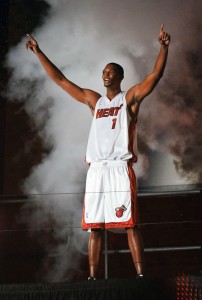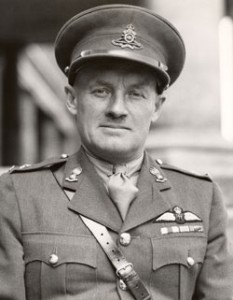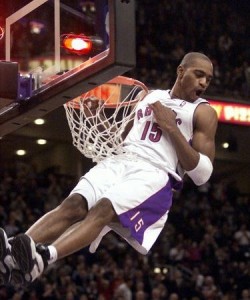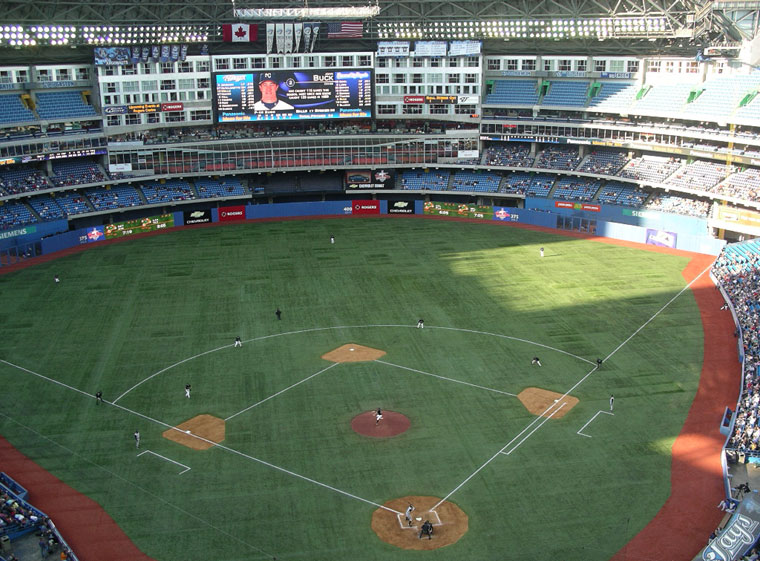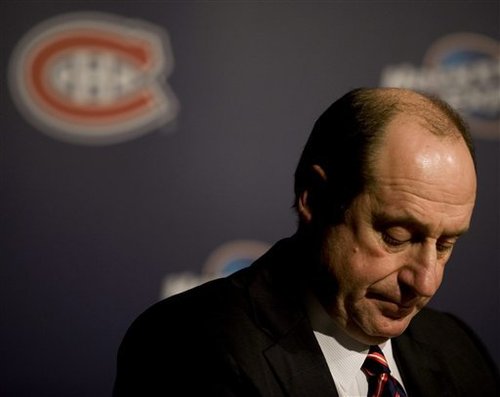Why is Chris Bosh going to be booed tonight?
Fans of the Toronto Raptors and Chris Bosh, the former star of the team, have been on a collision course since the National Basketball Association’s schedule was released two months ago.
Ever since Bosh announced he was signing with the Miami Heat, fans have been chomping at the bit to heckle and jeer him when he returns to Toronto. The wait is finally over, as Bosh’s Miami Heat will be at the Air Canada Centre tonight.
“I’m on another team,’’ he said to the Toronto Sun on Tuesday. “I would like it (to be liked) because that’s like a fairy tale ending or beginning, but that might not be the case.
“I’ll be ready for anything.”
Bosh can hope all he want, but he is going to be booed and heckled every time he steps in Toronto for the rest of his career. He will be subjected to as much vitriol as Vince Carter and Tracy McGrady are even though they’re years removed from their time on the Raptors.
Sadly, Bosh will probably never understand why he’s now the target of so much scorn in Toronto.
Ironically, the reason for the hatred is the same reason why he left: he doesn’t understand the character of the city.
He doesn’t understand that, ultimately, Toronto is a conservative place.
I don’t mean conservative in the modern, Glenn Beck, Republican sense, but the classical, small-c libertarian way, with an emphasis on individuality, entrepreneurship and, above all else, work ethic.
Founded by Governor John Graves Simcoe in 1793, the city historically stood in contrast to its Gallic cousin to the east, Montreal.
Largely inhabited by Protestants of British decent until the 1950s, Toronto’s early civic life focused on being loyal citizens to the crown, devoted members of their church and especially constructive members of the business world.
Those three characteristics earned Toronto nicknames likes “the Queen City” and “Toronto the Good”. Jokes about being able to shoot a cannon down Yonge Street on a Saturday night without hitting anyone were common. It was a staid, serious place.
Over time, monarchism and religiousness have faded and Toronto has become a more cosmopolitan, multicultural place with a vibrant nightlife. But that dedication to working hard and getting things done has remained at the core of the city.
The serious, stoic demeanour of Torontonians is often interpreted amongst other Canadians, perhaps fairly, as aloofness or even arrogance. There’s a coldness to how people carry themselves in Toronto, although defenders of the city would probably call it “walking with purpose”.
That indifference translates to the business world: It doesn’t matter who you are or where you’re from, as long as you put your nose to the grindstone and work hard, there’s a place for you in Toronto.
It’s that businesslike attitude has made Toronto the most multicultural city on Earth. It’s what makes Ontario’s capital the home of North America’s oldest continuously running Orangeman’s parade, but also allows Toronto to host one of the world’s largest LGBT Pride festivals every summer – the two seemingly contradictory events are held just weeks apart.
That spirit of efficiency and industriousness is what inspired Peter Ustinov to say “Toronto is New York run by the Swiss.”
Toronto’s workmanlike approach to, well, everything, has influenced the city’s sporting culture as well.
Like most things in Toronto’s sporting history it all starts with Conn Smythe.
The founder and long-time owner of the Maple Leafs favoured players who played a tough, relentless style of hockey. His motto of “If you can’t beat ‘em in the alley you won’t beat them on the ice” shaped the identity of the franchise, and set it apart from the free-wheeling finesse play of the rival Montreal Canadiens.
Smythe also set the tone for fan behaviour in Toronto, enforcing a strict dress code for fans at Leafs games. There’s a famous story that a wealthy couple rewarded their maid with their seasons tickets for the night. The morning after the game Smythe called the couple’s home, threatening to revoke their passes if anyone in their seats wasn’t wearing a shirt and tie or a proper Sunday dress, because the maid and her date hadn’t met Smythe’s high standards.
As a result, Torontonians have little interest in flashy athletes or raucous crowd behaviour. They want to quietly cheer on their teams and reward the players who work the hardest, not necessarily the ones with the best numbers.
Take the current roster of the Blue Jays as an example.
The most enduringly popular baseball player in Toronto this past decade is utility infielder John McDonald, despite his career .239 batting average.
I promise you that when the team’s line up is announced on opening day this spring the crowd reaction for perennial bench warmer McDonald will rival that of reigning home run king Jose Bautista.
Why? Because when McDonald does play, he puts his heart out on the field. A terrible batter, the 36-year-old veteran has won the love of Jays fans by never quitting on a play, and happily volunteering to do whatever the team needs him to do, including pitch relief or help out as the bullpen catcher.
Similarly, the Leafs have had a lengthy list of players renowned for their intensely physical style of play that has earned them the adoration of fans, even though their offensive numbers are far inferior to their contemporaries.
Players like Darcy Tucker, Tie Domi, Wendel Clark and Doug Gilmour will forever be deified in Toronto not for any goals they scored or any particularly outstanding play, but for the way they punished anyone who dared step on the ice against the Leafs.
Even when a truly gifted and talented player suits up for a Toronto franchise, it takes that same kind of hard-working, detail-oriented approach to win the fans’ devotion. Fortunately for sports fans in the city, the two best players to play in Toronto in the past 20 years are Roy Halladay and Mats Sundin, the quietest and most stoic athletes you can imagine.
This brings us to the Raptors and why poor Bosh is going to have hate, and possibly garbage, poured on him at the Air Canada Centre tonight.
It has little to do with loyalty – after all, both Halladay and Sundin left Toronto for greener pastures and they’re still beloved – and everything to do with how he left.
Whether they can articulate it or not, Torontonians are incensed by Bosh’s apparent rejection of their values.
Like Vince Carter before him, Bosh has left the Raptors to seek fame and fortune, to be flashy and find the spotlight of endorsement deals and American media attention. He left the cold, hard streets of Toronto for the glitzy nightlife of South Beach.
Worse yet, Bosh spent his last games with the Raptors sitting on the bench, nursing an injury. That is a cardinal sin to Torontonians: he was lazy.
Torontonians can understand, even appreciate, Halladay and Sundin leaving to win championships with better clubs - being rewarded for your hard work makes perfect sense to the city. But leaving for nightclubs and the easy life of sunny Florida? That is anathema.
It’s a shame, too. Bosh had showed so much promise when he was first drafted by the Raptors. Feature stories and interviews with the young rookie talked about how much work he was planning on doing in the off season. He openly discussed how he had to consume thousands of calories a day to bulk up for the more physical play of the NBA. Bosh liked to read. He was a computer science major in university.
In other words, he was perfect for Toronto.
Particularly after the disaster that was Carter’s time with the Raptors.
After all, Carter was a flashy style-over-substance player who briefly won the hearts of Raptors fans with the franchise’s deepest playoff run to date, only to blow it all by going to his university’s graduation ceremony instead of – that’s right – focussing on the task at hand and giving 100% to his team.
But slowly, the love affair between Bosh and Toronto soured. His charming videos of him working out became more self-aggrandizing and egocentric. It was less about industry and more about creating a brand.
Bosh had the negative example of Carter to try and avoid, but was also surrounded by positive role models like Matt Bonner, Jerome Williams, Morris Peterson and Jose Calderon. They’re all players who aren’t nearly as talented as Bosh, but who work hard on and off the court and were rewarded with the love and appreciation of the fans.
Instead, Bosh has opted to make a cameo on Entourage, film navel-gazing documentaries on getting his first tattoo and make over-the-top appearances with James and Dwyane Wade announcing how many championships they’re going to win with the Heat.
Bosh left because he felt like Toronto wasn't the place for him to reach the level, not just on the court, but off of it. He was right. It's no place for someone seeking fame, because they'll never find it here. The city spurns superstars.
Raptors fans, the supporters of any sports team in this city, will always favour the quiet, hard-working bench warmer over the flashy star with all the merchandise. Bosh's vision just couldn't line up with what the city demands of its sports heroes. That's not his fault, or Toronto's, it's just the way it's meant to be.
Unfortunately for Bosh, all this adds up to one thing: Toronto is going to show him no mercy. Not necessarily because he betrayed the city’s trust or because he is a bad player or because Raptors fans are particularly spiteful, but because he’s turned his back on the values the city holds most dear. Effort. Hustle. Hard work.
Chris Bosh is going to be booed tonight and for the rest of his career because he rejected the core value that governs behaviour in Toronto. He unknowingly struck at the city’s core principle, and Raptors fans will be unable to forgive him for that.
What is the best team in Toronto?
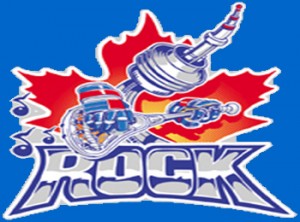 Toronto sports fans are lucky – they live in one of the few cities in North America to have a professional sports team in all four major leagues.
Toronto sports fans are lucky – they live in one of the few cities in North America to have a professional sports team in all four major leagues.
Well, okay, there isn’t really a National Football League team here, but the Buffalo Bills play two games a season at the Rogers Centre and there are the Toronto Argonauts, historically the Canadian Football League’s most successful team. Football is definitely covered in Canada's largest city.
But I digress. Toronto has eight professional sports teams, on a par with, or better than, the 14 American cities that have teams in the NFL, National Basketball Association, Major League Baseball and the National Hockey League.
Unfortunately, this creates a weird competition amongst the teams as they vie for fans attention. I was reminded of this weeks ago when a friend of mine from senior school posted on Facebook “So glad the Leafs suck more than the Raps. At least the Raps have upside”.
Of course, this was before the Raptors embarked on a Cavaliers-esque 13-game losing streak, but the comment got me wondering: what is the best team in Toronto? Which team does the best job of representing a city spoiled for choice?
Here are all of the city’s professional sports franchises, in order of winning percentage over the past two years.
| Team | This season | Last season | Cumulative |
| Rock | .667 (4-2)* | .562 (9-7)† | .615 |
| Blue Jays | .525 (85-77) | .463 (75-87) | .494 |
| Marlies | .470 (24-20-7)* | .413 (33-35-12) | .442 |
| Nationals‡ | .250 (3-9) | .583 (7-9) †¥ | .417 |
| Maple Leafs | .426 (23-26-5)* | .366 (30-38-14) | .396 |
| Raptors | .269 (14-38)* | .488 (40-42) | .379 |
| Argonauts | .500 (9-9-0) † | .167 (3-15-0) | .336 |
| Toronto FC | .300 (9-13-8) | .333 (10-11-9) | .317 |
Notes: * - Season currently underway.
† - Made the playoffs.
¥ - Won championship.
‡ - It was announced in the offseason that the Toronto Nationals have moved to the bustling metropolis of Hamilton, Ont., for 2011.
What’s most apparent in this chart is that it’s good to be a fan of lacrosse in Toronto. Especially if you live in the western part of the Greater Toronto Area, since Major League Lacrosse’s Toronto Nationals – the most recent champions in the city – are moving to nearby Hamilton.
But if you want to see a Toronto-based team do well in the regular season and go deep in to the postseason, you’d better pick up the nuances of lacrosse. The Rock are the best team in the NLL this year after losing a close game in the league championship last season.
Further, six of Toronto’s last nine championships have come from lacrosse teams, with the Rock contributing five and the Nationals bringing home the Steinfeld Cup two summers ago. The other three are all thanks to the Toronto Argonauts winning the Grey Cup in 1996, 1997 and 2004.
It’s also worth noting that attendance is seemingly unaffected by a team’s success.
Most Torontonians would immediately twig to the fact that the Maple Leafs, the city’s fifth best team, remain the most popular franchise while the Blue Jays – ranked second – had serious attendance problems last summer.
But what I find most striking is that Toronto FC, the team with the most passionate fans, has the worst record of Hogtown’s professional sports franchises.
In any event, I think this is an interesting exercise that would test perceptions of Toronto’s sports teams. Tell me: were there any surprises on this chart for you?
My latest for HPT.com – Like his personality, Burns leaves large legacy
I'm particularly proud of my work last weekend for HockeyPrimeTime.com. I wrote a brief piece on Pat Burns' impact on the National Hockey League's Northeast Division and my hockey fandom. Check it out and tell me what you think.
Like his personality, Burns leaves large legacy
A former policeman, Burns looked the part behind the bench with his thick moustache, but didn’t act like any cop that would visit my elementary school or volunteer with my Cub Pack. He was always yelling, screaming or trying to get at the other team’s bench. My parents had to awkwardly explain what he’d just said to the referees that had gotten him in so much trouble. (Although I had no problem understanding the idea of sending him to the locker room as punishment.)
He was easily my favorite of the Leafs. As news of Burns’ death spread Friday night, it quickly became clear I wasn’t the only one.
Top 10 ideas the National Hockey League should institute
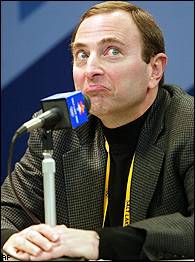 With the National Hockey League’s 30 general managers currently meeting in downtown Toronto to discuss changes to rules and policy, I figured I’d take the opportunity to chime in with my two cents. Times 10. My 20 cents, if you will.
With the National Hockey League’s 30 general managers currently meeting in downtown Toronto to discuss changes to rules and policy, I figured I’d take the opportunity to chime in with my two cents. Times 10. My 20 cents, if you will.
Lengthen overtime
Extending overtime is already on the table as the GM’s try to cut down on the number of shootouts, but I wanted to voice my support for this idea.
Right now, the extra period is just five minutes of 4-on-4 followed by the shootout. OT is the tensest period of play in any hockey game with each penalty, missed pass or deflected shot putting the game on the line.
There’s been a lot of talk of having five minutes of 4-on-4 and then five of 3-on-3. The former doesn’t really strike me as too interesting - I don’t see why they couldn’t just do 10 minutes of 4-on-4, or, what the hell, a full 20 minutes of 4-on-4 followed by the shootout.
It’ll still cut down on the number of shootouts and will create more tension and therefore more excitement. Fans tend to enjoy excitement.
Get rid of archaic blackout rules
As I’ve mentioned before, my fiancée Katy and I are a mixed couple – I’m a Leafs fan and she supports the Oilers.
It makes for the occasional tense moment, but what really aggravates things is that we can only watch the Leafs and rarely the Oilers thanks to the NHL’s ridiculous TV blackout rules. This regulation prevents anyone with a standard cable package from watching an out-of-market hockey game.
In other words, although Sportsnet West was carrying the Edmonton-Carolina game last night, we could only watch the Toronto-Tampa Bay match or the Washington Capitals-New York Rangers game. I understand the original reasoning behind this rule was to keep fans interested in their hometown markets.
However, this hurts the NHL more than it helps. If a fan in Minnesota wants to cheer for the Pittsburgh Penguins, then so be it. Associating yourself with frustrating rules that limit your fans ability to watch your product is never a good idea. Dropping this ridiculous regulation would also tie in with…
Embracing fantasy hockey
I think we can all agree that the National Football League is the best run professional sports league in North America and arguably the world. So why not tear a page out of their playbook and embrace fantasy sports?
In addition to showing the scores from games, the NFL runs tickers of the top five stat lines from each position during their Sunday broadcasts. That running update on the individual success of its players is aimed straight at fantasy football managers eager to see how their personal team is doing.
The NHL should do likewise: run a ticker with the statistics of the top five forwards, defenders and goalies each and every broadcast night.
Clamping down on vague “lower body injury” reports would be a good idea as well. Force the teams to reveal more details about their hurting players for the benefit of fantasy hockey managers. Anything to make fantasy hockey more accessible and enjoyable.
Show where shots are coming from and going
This has long been a bugbear of mine. During games broadcasters will happily tell you how many shots a goalie has faced. That’s all well and good, but not all shots were created equal. A shot from the slot is a lot more dangerous than one from the blue line.
Hockey broadcasts should show where on the ice players are shooting from and where they’re going on net. The technology is already there – Major League Baseball can track the trajectory of pitches and the National Basketball Association regularly shows where players shoot from on the court.
Both concepts should be applied to hockey. It would really help viewers understand the underlying strategies and tactics within a game as patterns begin to emerge in shot selection and location.
Is the defence successfully pushing forwards to the outside? Are they giving up a lot of breakaways? Is the power play unit feeding to the rearguard for big shots, or working it down low? Are shooters trying to pick top corners, or shooting along the ice for big rebounds? It would really add more depth and understanding for the average viewer.
No touch icing
The favourite hockey cause of the CBC’s Don Cherry, no touch icing is an idea that is long past due. With increasing concerns about head shots and concussions, why is the NHL persisting in having a rule that routinely has two players racing the full length of the ice toward unforgiving boards? Just take it out of the game already!
Crossover playoffs
The NHL has a lengthy and rich history, particularly amongst its storied Original Six franchises.
Unfortunately, thanks to their current playoff system, many of the oldest rivalries in the game will never be put on the league’s biggest stage: the Stanley Cup final.
The Montreal Canadiens and Toronto Maple Leafs, the biggest and best feud in all of hockey will never play with the NHL championship at stake again. Neither will the Chicago Blackhawks and Detroit Red Wings or the Habs and Boston Bruins.
My solution is actually an old idea: have the top 16 teams in the league in one playoff pool. President’s Trophy winner will take in the 16th seed, the other conference champion will take on No. 15, and so on. It’s how the playoffs were structured in the 1970s and 80s, and it’ll work again today.
Get back in touch with the history of the game
Other than the MLB, there is no major North American sport that has as rich a history as the NHL. Unfortunately, commissioner Gary Bettman clearly sees this as a weakness and tries to cover up or even undo a lot of the league’s historical underpinnings.
This is a mistake.
By shying away from that history it makes the NHL seem like a new, fly-by-night operation, particularly when franchises are being parachuted into Sunbelt markets that are unfamiliar with the game.
The NHL should embrace its past with throwback jerseys, prominent marketing of its namesake trophies (like the Lady Byng) and make sure to compare today’s stars with some of the legends of hockey. History and tradition are strengths, not weaknesses.
No more two-piece sticks
Look, I’m all for innovation. I’m not some Luddite who poo-poos every new idea. But let’s get real: two-piece hockey sticks break a lot more than good ol’ fashion wooden sticks.
Not only is this dangerous to players, linesmen and potentially fans, but it slows down the game as the remnants of that $200 fibre composite is cleared off the ice. If an all-wooden stick was good enough for Al MacInnis’ record holding slap shot, it’s good enough now.
Reinvest in amateur hockey
I don’t actually think that the Sun Belt expansion was that bad an idea. New markets and new fans really can work. It just wasn’t done right.
The NHL should take the time to invest in amateur hockey at the grassroots level because those are the fans – and players – of the future.
Amateur hockey would help educate parents and kids about the sport and create an instant niche market of coaches taking their teams to games.
When moving in to Phoenix, Miami or Atlanta the league should have set up minor hockey systems to introduce those cities to the sport. Obviously, that ship has sailed, but it might help with some damage control if they got local kids involved in the game.
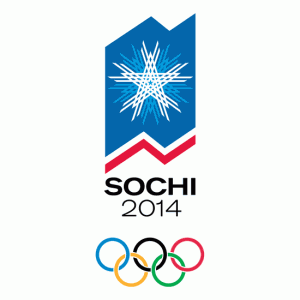 Send NHLers to the 2014 Sochi Olympics
Send NHLers to the 2014 Sochi Olympics
This was, of course, a hot-button debate at the World Hockey Summit this summer, but it’s worth mentioning again.
Bettman and co. must let NHLers play in the Olympics, and they should make that announcement sooner rather than later.
Why? Because although the Stanley Cup and the Winter Classic do a great job of raising hockey’s profile, nothing does a better job of exposing the sport to the masses like the Olympics. Nothing.
This year’s men’s hockey final between the United States and Canada was the most watched hockey game, ever. It drew 44.2 million viewers across North America and was the main event of the two week sporting event.
The NHL would be foolish to give up that kind of mainstream media attention. Bettman should make the announcement soon as well and what better place than this year’s newly reformatted All-Star Game?
What do you think? What ideas do you have for the NHL GMs? Post them in the comment section below.
Stadium Review: Rogers Centre
As regular readers of this blog know, I’ve been to several ballparks in this past year. Last summer I went to Detroit’s Comerica Park, while this July I went to New York City’s New Yankee Stadium and Citifield.
However, I had never considered reviewing the Rogers Centre, the ballpark in my hometown Toronto. Not because it’s unworthy, but because I was worried that I would be too hard on a stadium that has become a scapegoat for the attendance woes of the Toronto Blue Jays as well as the Canadian Football League’s Toronto Argonauts.
But on Tuesday night I returned to the former SkyDome after a month without attending a Jays home game and I realized, hey, this isn’t so bad.
First of all, I was buoyed by the recent ESPN study that found the Rogers Centre to be one of the cleanest stadiums in all of professional sports, a small club that includes the Air Canada Centre, home of the Toronto Maple Leafs and Toronto Raptors. There are only nine other venues that have spotless health records.
Also, after my 45 minute subway ride to Citifield in Queens, New York, I have found a new appreciation for the downtown location of the Rogers Centre. It’s a five minute walk through a dedicated passage from Union Station, giving the ballpark access to the Toronto Transit Commission and the provincial GO Trains.
The neighbourhood is ideal for out-of-towners hoping to kill some time before the opening pitch. Right beside the ballpark is the CN Tower, the second tallest structure in the world. Across the street is the Steam Whistle Brewery that serves one free sample beer to any visitor over the age of 19 and also has a variety of antique train engines.
Although it lacks the charm of the newer retro-styled parks like Citifield, Comerica and New Yankee Stadium, the Rogers Centre has all the same amenities with large and conveniently placed washrooms that are easier to find than the facilities at the American stadiums.
Of course, the former SkyDome’s big draw is its roof. Although it seems like a quaint 1980s concept, the retractable dome remains practical in a city that can have snow in April. The closed dome also means that the stadium is useful all year around.
Don’t get me wrong, there Rogers Centre does have its drawbacks, especially the feeling that it is always half-empty. It can’t be helped - its seating capacity is fifth largest in Major League Baseball but Toronto averages the fourth smallest crowd in the Majors. As a result, the stadium seems deserted for most games.
As far as service goes, the staff at concessions and in the stands are fine. However, the public announcer and the rest of the in-game entertainment seem desperate to energize the staid Toronto crowd. They don’t seem to realize that Torontonians are almost always quiet at concerts, festivals and other events. It’s just in the city’s character.
Unfortunately, this year they’ve tried to boost the crowd’s excitement by cranking the music as loudly as possible, stifling conversation and drowning out any attempts at chants or cheers from the crowd. The stadium may not be quiet, but the crowd is. It distracts from the action on the field and takes away from baseball’s pastoral roots.
Toronto’s Rogers Centre is far from perfect, but it’s also not the worst ballpark I’ve ever been to. It’s accessible by public transit and is reasonably priced. It’s clean and family friendly. Unlike Fenway Park or Yankee Stadium it’s better suited to locals than visiting fans, but that’s not a serious offence for a stadium. It serves the city of Toronto admirably.
Taking Care of Business
It has been three weeks to the day since I last posted on here, and for that, I am sorry.
It just couldn't be helped though - I’ve been very busy with my continuing work at Canada’s Sports Hall of Fame. The good news is that most of my work is now done, and the final stage should be completed in about mid-July.
My work hasn’t been limited to freelancing for the Hall of Fame though. I’ve been spending the summer doing pagination for the Canadian Press, as well as a few side projects.
The first of these projects was for my friend Victor Bachmann, a professional mixed martial artist based in Edmonton. I had interviewed him years ago for a Canadian fighting magazine. Unfortunately, they never had the space for the article and its references quickly became dated.
In addition to his prizefights, Victor is a teacher at the Hayabusa Fighting Training Centre, and he needed a profile for the gym’s website. Remembering the story I’d written about him, Victor asked me to re-write it for him.
I’ve never had to re-write an article so dramatically before, but I think I really sharpened this piece up.
My other project was for HockeyPrimeTime.com, a website that covers the National Hockey League.
Their editor, J.P. Hoornstra, asked me to do a preview of the Northeast Division’s draft possibilities and I happily complied.
It was a lot of fun looking at the different needs and draft picks of the hockey teams I am most familiar with: the Boston Bruins, the Buffalo Sabres, the Montreal Canadiens, the Ottawa Senators and the Toronto Maple Leafs.
The next few weeks are all laid out for me - I’ll be doing a preview of the free agent prospects of the Northeast Division teams for HPT.com and completing my work with Canada’s Sports Hall of Fame. Fortunately, I’ll also have more time to do blog posts.
The Case for Pat Burns’ early induction into the Hall of Fame
 A week ago I tweeted about the movement to have Pat Burns inducted into the Hockey Hall of Fame. I had wanted to expand on that 140-character missive, but the Easter holidays got in the way. However, now I’ve got the chance.
A week ago I tweeted about the movement to have Pat Burns inducted into the Hockey Hall of Fame. I had wanted to expand on that 140-character missive, but the Easter holidays got in the way. However, now I’ve got the chance.
As TSN later reported, the Facebook group Let's Get Pat Burns into the Hockey Hall of Fame - NOW! has the support of tens of thousands of hockey fans - over 49,000 as I write this – to put the former National Hockey League coach into the Hall of Fame before he succumbs to terminal cancer.
Other media outlets have picked up on the page, including Hockey Night in Canada, Coast to Coast with Don Cherry, the Montreal Gazette, the Toronto Sun, the Toronto Star and several radio stations.
Burns has a wealth of accomplishments that should earn him a spot in the Hall of Fame.
In his 14 straight seasons as a head coach he won 501 games with four teams, making it to the playoffs 11 times, the final twice and winning the Stanley Cup once.
To put that in a historical perspective, Burns is 11th in NHL history for number of games coached, nine behind Brian Sutter.
Burns is also 11th on the list for coaching wins, just one behind Hall of Fame member Glen Sather.
Even his losses stack up well, with Burns dropping 353 decisions in regulation and 14 in overtime (OTL was only counted in his last four seasons). That’s significantly less than Jacques Demers (468) and Brian Sutter (437), both of whom also coached for 14 years.
Granted, Burns doesn’t come anywhere close to the top 10 in terms of Stanley Cup wins, but he does at least have that one Stanley Cup ring from the 2002-03 New Jersey Devil’s championship, which is better than many other members of the Hall of Fame.
One could speculate that had it not been for Burns’ premature retirement, he’d have moved even further up these lists. Certainly, he could have moved up on the lists for games coached, and presumably climbed further up in terms of wins.
However, the Hall of Fame shouldn’t rely upon conjecture or presumptions. The man’s record speaks for itself. Even within the constraints of his shortened career he put together an exceptional coaching record.
The only question is whether or not Burns will be alive by the time he is inducted into the Hall of Fame.
Burns was present at the groundbreaking ceremony of a hockey arena that will be named in his honour two weeks ago. During the press conference, Burns was not optimistic about his chances of seeing the rink completed.
"I probably won't see the project to the end," said Burns. "But let's hope I'm looking down on it and see a young Wayne Gretzky or Mario Lemieux."
Normally, there is a three-year waiting period after retirement to gain admission to the Hockey Hall of Fame.
However, there is precedent for the Hockey Hall of Fame speeding the process up: Roger Neilson was fast-tracked as he was terminally ill, as was Mario Lemieux, whose Hodgkin's lymphoma appeared to be fatal.
Burns has everything going for him. He has a high-calibre resume, the support of many hockey insiders and the Hall of Fame has done this kind of promotion before.
All that’s left is for the selection committee to take note of his accomplishments and the groundswell of support for his induction. It would be a fitting cap to a stellar career and an inspiring life.
If you’d like to throw your support behind the Let's Get Pat Burns into the Hockey Hall of Fame - NOW! Facebook group, you can join by clicking on this link.
Book Review: King Leary by Paul Quarrington
 Paul Quarrington’s novel King Leary is a funny, insightful look at the world of professional hockey in the early 20th century that would be enjoyable for fans of the sport or someone looking for a quick read.
Paul Quarrington’s novel King Leary is a funny, insightful look at the world of professional hockey in the early 20th century that would be enjoyable for fans of the sport or someone looking for a quick read.
Published in 1987, Quarrington’s tale won the Stephen Leacock Medal for Humour in 1988 and was shortlisted for that year’s Trillium Book Award.
It regained prominence in 2008 when the Rheostatics' Dave Bidini championed it for the CBC’s Canada Reads program. Bidini’s campaign saw King Leary become a best-seller and win the award 10 years after it first appeared on book shelves.
Narrated by Percival “King” Leary, one of the greatest professional hockey players to ever live, the story follows him as he travels from his retirement home to Toronto to shoot a ginger ale commercial with Duane Killebrew, the National Hockey League’s current scoring champion.
During the trip Leary recalls how he learned to play while at reformatory school and his complicated friendships with Clay Bors Clinton and Manfred Ozikean. He also touches on the fractious relationships with his sons Clarence and Clifford, as well as his wife Chloe and her sister Jane.
For the reader less familiar with hockey, King Leary will entertain with its amusing anecdotes and poignant moments. Quarrington is a masterful storyteller, subtly hinting at darkness that seeps into an otherwise humorous narrative.
Literary minded hockey fans will appreciate his nods to the major figures in the game’s lore. Quarrington works in several real-life legends of the game like Georges Vezina and Eddie Shore.
At the same time, many of the characters are clearly based off other historical figures. Clinton is a mix of Conn Smythe and Harold Ballard. Killebrew is clearly meant to be Wayne Gretzky, with a passing reference to a player “down in Pittsburgh” that hints at Mario Lemieux.
Leary himself resembles a number of players, especially Toronto Maple Leafs great Francis Michael “King” Clancy.
The one disappointing aspect of the book is that although Quarrington is deft at the characterization of all of the main characters, supporting characters like Leary’s nurse Iain or the advertising executive Claire are painted with an extraordinarily broad brush. Their dialogue seems forced and unnecessarily flamboyant to the point that their characters are a distraction that clutters the page.
Aside from that, King Leary is a fine story. A quick reader could blow through Quarrington’s work in an afternoon, and would enjoy it regardless of their attachment to Canada’s favourite game. Definitely worth picking up.
Trade deadline day is over-rated
 Although I’m still a young pup in this sports journalism game, most of my friends and family, as well as people following me on Twitter, have often ask me for my opinion on major events in sports.
Although I’m still a young pup in this sports journalism game, most of my friends and family, as well as people following me on Twitter, have often ask me for my opinion on major events in sports.
As you can imagine, I took lots of questions about the National Hockey League’s trade deadline. People wanted to know about what deals I thought would happen and how I felt about the moves teams made.
You know what? I didn’t think much of it at all. It’s a boring, media-generated event that is over-hyped.
This wasn’t always the case. I remember being an undergraduate at the University of Toronto and stopping people on the street to ask if they’d heard what the latest trade was and congregating with friends between classes to talk about the latest move.
Back then, big names were thrown around. I remember the palpable sense of excitement when the Toronto Maple Leafs landed Owen Nolan in 2003. I also remember the sense of regret and foreboding when the Leafs missed out on Rob Blake in 2001.
The difference between then and now is that the post-lockout collective bargaining agreement has instituted a salary cap (as well as a minimum) for all teams. Adding a big ticket player destroys any franchise’s budget. This cap makes crazy, last minute moves virtually impossible.
Yes, there have been some major moves made close to or on the deadline like Marian Hossa joining the Pittsburgh Penguins in Feb. 2008 or this year’s trade of Ilya Kovalchuk from the Atlanta Thrashers to the New Jersey Devils. But these deals were motivated by teams trying to dump expiring contracts before the free agents walked away for nothing. They are very temporary, and took months to negotiate.
Instead of the free-wheeling desperation deals of yore, trade deadline day consists of a gaggle of analysts trying to fill air time between commercials for hours on end.
I watched TSN’s coverage, which spent several segments introducing the many commentators they’d employed for the day. After nearly three hours of coverage they began to break some news, like the thrilling trades of Derek Morris for a fourth round pick in 2011 or Martin Skoula (being traded by a team he never played with) for a fifth round pick. Yawn.
If you really want to see exciting personnel moves in the NHL, wait for free agency to open up in the summer. That’s where teams are made in this day and age, not at the trade deadline. No, now the last day of the deal-making season is the home of third line centres and depth defencemen.
Gainey’s departure hurts the Habs more than it helps
Bob Gainey resigned from his position as general manager of the Montreal Canadiens Monday afternoon, making way for interim GM Pierre Gauthier.
Say what you will about Gainey’s tenure as the boss in Montreal - and many people have - I think we can all agree that the timing could not be worse.
The Canadiens are currently in sixth place, at the top of the Eastern Conference’s playoff log jam. They’re one point ahead of the Philadelphia Flyers and the Tampa Bay Lightning, and, incredibly, just 13 points ahead of the last place Toronto Maple Leafs.
With 22 games left in their season, anyone could overtake Montreal. The East is wide open. As unlikely as it seems, even Toronto could wind up in the postseason.
Between now and the playoffs there is also a little event called the trade deadline, where the Habs will undoubtedly be looking to move one of either Carey Price or Jaroslav Halak. Also, prized centre Tomas Plekanec is entering into negotiations to sort out his contract for next season. Otherwise he’ll be an unrestricted free agent, able to sign with the highest bidder.
This is the time for a strong leader, one who can represent the franchise and present themselves as a powerful figure who has the support of ownership. Gauthier may be a canny negotiator, but the word “interim” in front of his title will be a handicap.
GMs from other teams will try to fleece the Canadiens for Price and Halak, knowing that Gauthier must move one of them and that he is only in charge by default. Don’t believe me? Ask John Ferguson Jr. what it’s like to try and work deals without the full, vocal support of your ownership. Ask Cliff Fletcher what it’s like trying to swing a trade when you’re just an interim GM.
Further, Plekanec’s agent will have a hard time taking Gauthier seriously. There’s more than just money at stake when you sign a free agent. They also want to be on a winner. Since Gauthier will probably be relieved of his duties in the off-season, he can’t make any kind of guarantee of what the team will look like in the 2010-11 season. He stinks of lame duck.
That cannot be appealing to the Plekanec camp.
During Monday’s press conference Gainey said he had to leave because he couldn’t take the day-to-day grind of being a GM any longer.
That may be so, but he’s left his team in the lurch. If he could have bucked up until the off-season, he would have broken ties with the Canadiens at an optimal time. Instead, his departure might distract the Habs during their playoff run and will undoubtedly hinder personnel negotiations.
